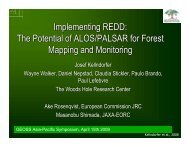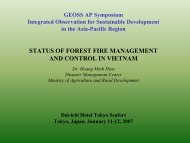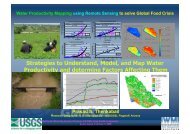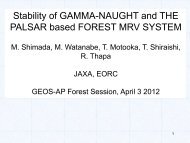AN OVERVIEW OF REDD+ ACTIVITIES IN MALAYSIA
AN OVERVIEW OF REDD+ ACTIVITIES IN MALAYSIA
AN OVERVIEW OF REDD+ ACTIVITIES IN MALAYSIA
Create successful ePaper yourself
Turn your PDF publications into a flip-book with our unique Google optimized e-Paper software.
<strong>AN</strong> <strong>OVERVIEW</strong> <strong>OF</strong> <strong>REDD+</strong><br />
<strong>ACTIVITIES</strong> <strong>IN</strong> <strong>MALAYSIA</strong><br />
Hamdan Omar<br />
Forest Research Institute Malaysia (FRIM)<br />
5 th GEOSS-AP Symposium<br />
2-4 April 2012, Miraikan, Tokyo, JAP<strong>AN</strong>
Presentation Outline<br />
1. Forest in Malaysia<br />
2. <strong>REDD+</strong> in Malaysia<br />
3. Ongoing <strong>REDD+</strong> Projects<br />
4. Case Studies on Forest<br />
Carbon Tracking<br />
Slide No.<br />
3 - 7<br />
8 - 18<br />
19 - 35<br />
36 - 46
Forest in Malaysia<br />
(‘000,000 ha)<br />
Non-Forest<br />
14.13<br />
5.86<br />
9.24<br />
Pen. Malaysia<br />
3.62 Sabah<br />
Sarawak
Distribution and extent of major forest types<br />
in Malaysia, 2010 (‘000,000 ha)<br />
Region<br />
Land<br />
Area<br />
Dry Inland<br />
Forest<br />
Natural Forests<br />
Swamp<br />
Forest<br />
Mangrove<br />
Forest<br />
Total<br />
Forested<br />
Land<br />
% of<br />
Total<br />
Land<br />
Area<br />
Pen. M’sia 13.18 4.58 0.24 0.10 5.86 44.4<br />
Sabah 7.37 3.17 0.12 0.32 3.61 49.0<br />
Sarawak 12.30 7.98 1.12 0.14 9.24 75.1<br />
Malaysia 32.85 15.73 1.48 0.56 17.77 54.1<br />
Sources: Forestry Department Peninsular Malaysia (2011)<br />
Sabah Forestry Department (2011)<br />
Forest Department Sarawak (2011)
Permanent Reserved Forest in Malaysia,<br />
2010 (‘000,000 ha)<br />
Region Protection Forest Production Forest Total PRFs<br />
Pen. M’sia 1.98 2.82 4.80<br />
Sabah 1.04 2.55 3.59<br />
Sarawak 1.10 5.00 6.10<br />
Malaysia 4.12 10.37 14.49<br />
Sources: Forestry Department Peninsular Malaysia (2011)<br />
Sabah Forestry Department (2011)<br />
Forest Department Sarawak (2011)<br />
# Sustainable Forest Management (SFM) is being practiced for all PRFs.
Forest Area in Pen. Malaysia (1966 – 2009)<br />
§ Blue : Department of Agriculture Malaysia (Land Use Map P. Malaysia)<br />
§ Red : Forestry Department Peninsular Malaysia
Changes in Forest Area<br />
Area in million ha<br />
16 <br />
14 <br />
12 <br />
10 <br />
8 <br />
6 <br />
4 <br />
2 <br />
1990 系 列 1<br />
2007 系 列 2<br />
0 <br />
Permanent<br />
Reserve<br />
Forest<br />
Totally<br />
Protected<br />
Areas<br />
Stateland Rubber Oil Palm<br />
系 1990 列 1 12.6 1.12 6.8 1.84 2.03<br />
2007 系 列 2 14.3 1.95 3.42 1.21 4.44
Malaysia and <strong>REDD+</strong><br />
Malaysia is not part of the UN-REDD or the World Bank Forest Carbon<br />
Partnership Facility (FCPF), but it has expressed interest in participating in<br />
REDD programmes.<br />
In a submission to the Subsidiary Body for<br />
Scientific and Technological Advice (SBSTA) of<br />
the UNFCCC Malaysia expresses its views on<br />
REDD. The submission emphasises that the<br />
system must be designed in a way that is<br />
favourable also for countries with currently low<br />
deforestation rates.<br />
It also promotes the inclusion of selective<br />
harvesting and sustainable forest management<br />
(SFM). Malaysia has set an ambitious goal of<br />
preserving 50% of the country’s surface forested<br />
(Ministry of Science, 2000). This is to be attained<br />
through natural regeneration.
Prime Minister has made a voluntary pledge to<br />
reduce emissions intensity of GDP by up to 40%<br />
compared to 2005 levels by 2020 at COP15
<strong>REDD+</strong> Implementation<br />
• The National Steering Committee on <strong>REDD+</strong> will provide<br />
guidance and recommendation on the <strong>REDD+</strong> implementation in<br />
Malaysia<br />
• The Committee also provides guidance on methodology and<br />
technical issues<br />
• <strong>REDD+</strong> activities will be implemented by the respective State<br />
Forestry Departments guided by the National <strong>REDD+</strong> Strategy<br />
and State’s Development Plan and Policies or State <strong>REDD+</strong><br />
Policy but reported at national level
Roadmap for <strong>REDD+</strong> Framework Strategy<br />
Parallel Processes:<br />
1: NBSAP – review BioD+ relevant policies + action plan (2011 – 2014)<br />
2: ABS: Includes FPIC & BDS (by 2012)<br />
3: NC3 – NAMA (2011 – 2015)<br />
4: Sabah REDD readiness (2010 – 2012)<br />
5. EPU- PES
Phase<br />
<strong>REDD+</strong> Phases<br />
Scope<br />
1. Readiness • National <strong>REDD+</strong> Strategy<br />
• Capacity building<br />
• Institutional strengthening/arrangement<br />
2. Implementation of<br />
National <strong>REDD+</strong> Strategy<br />
3. Full scale <strong>REDD+</strong><br />
implementation<br />
• Implementation of National <strong>REDD+</strong><br />
Strategy<br />
• Pilot projects<br />
• Quantified changes in GHG emissions and<br />
removals<br />
Total duration 3-5 years
COP 16 Decision<br />
Formalized the adoption of REDD Parties agreed on the following:<br />
(a) A national strategy or action plan<br />
(b) A national forest reference emission level (REL) and/or<br />
forest reference level (RL) or, if appropriate, as an interim<br />
measure, sub-national RL & REL<br />
(c) A system for providing information on how the safeguards<br />
referred are being addressed and respected throughout the<br />
implementation of the <strong>REDD+</strong>
Development of RL&REL<br />
• Funding from 10th MP (2011 – 2015)<br />
• Land use change assessment: 1990-2010<br />
• Land use and forest maps<br />
• Historic emissions and removal<br />
• Deforestation & degradation rates<br />
• Forest cover against GDP and Population growth
<strong>REDD+</strong> Activities
Our Progress<br />
National<br />
definitions for<br />
deforestation<br />
and forest<br />
degradation<br />
Drivers to<br />
deforestation<br />
s and forest<br />
degradation<br />
National baselines:<br />
- Trends between<br />
population and GDP<br />
on forest cover<br />
- Overall trends in<br />
forest cover<br />
changes<br />
Sub national<br />
reference level<br />
REL/RL<br />
1. Peninsular<br />
Malaysia<br />
2. Sabah<br />
Capacity<br />
building<br />
National Forest<br />
Monitoring System<br />
• Standard<br />
Methodology for<br />
NFI<br />
• Standard for<br />
geospatial<br />
monitoring and<br />
analysis<br />
Deliverables (2012)<br />
Handbook on REDD<br />
Implementation<br />
Institutional<br />
arrangement for<br />
<strong>REDD+</strong><br />
implementation<br />
Baselines and sub<br />
national REL/RL for<br />
P. Malaysia and<br />
Sabah<br />
Capacity building<br />
activities<br />
- Workshop<br />
- Seminar<br />
National<br />
Procedures for<br />
NFI
The “D” Definitions<br />
Deforestation<br />
• Human induced permanent conversion of forest land to nonforest.<br />
• All of the forest is cut and the land is cleared and used for<br />
another purpose. Forest refers to Permanent Reserved<br />
Forest/Permanent Forest Estate, Protected Area/Totally<br />
Protected Areas.<br />
• Temporary change in land use, like one rotation tree crop (up<br />
to 25 years) within forest reserves are not considered as<br />
deforestation<br />
Forest<br />
Degradation 1<br />
• A direct, human-induced decline in forest canopy cover<br />
up to 70% of the existing forest canopy cover or at least<br />
50% of existing forest carbon stocks<br />
• Not qualifying as deforestation<br />
1 Definitions and drivers of deforestation and forest degradation were proposed at the 1 st National<br />
REDD Workshop, 23 March 2011, Petaling Jaya
National REDD Readiness for Malaysia<br />
JPSM, SFD, FDS, FRIM, WWF<br />
USD693,548: 2011-2013<br />
Funder: UNDP, GoM<br />
Sabah REDD Readiness<br />
Sabah Forestry Department<br />
$4 mil Euro: 2011-2013<br />
Funder: European Union<br />
ITTO REDDES<br />
FRIM/Pahang FD<br />
USD 835k: 2012-2015<br />
Funder: ITTO<br />
Development of MRV for <strong>REDD+</strong><br />
FRIM/FFPRI: P. Malaysia<br />
¥15 Mil: 2010-2014<br />
Funder: FFPRI<br />
Kyoto & Carbon Initiative<br />
FRIM/JAXA: P. Malaysia<br />
2012-2014<br />
Funder: FRIM/JAXA<br />
Carbon Mapping of Greater Mekong & M’sia<br />
Forest Research Institute Malaysia: Malaysia<br />
~USD 96k: 2011 - 2013<br />
Funder: APFNet
Aims: Developing a national framework that includes the policy,<br />
legal and institutional components for <strong>REDD+</strong><br />
Reduce emission 40% in 2020 compared to 2005 levels
Development of MRV for <strong>REDD+</strong><br />
FRIM/FFPRI: P. Malaysia<br />
¥15 Mil: 2010-2014<br />
Funder: FFPRI<br />
Development of Forest Carbon Monitoring Methodologies For<br />
<strong>REDD+</strong> In Malaysia<br />
DURATION: 2011-2013<br />
CONTRIBUTO Forest and Forest Products Research Institute (FFPRI), Japan<br />
R:<br />
SITE<br />
Peninsular Malaysia<br />
LOCATION:<br />
OBJECTIVE: i. To monitor land uses and land-use changes using remote<br />
sensing techniques<br />
ii. To monitor forest carbon stocks by ground sampling<br />
iii. To analyst the forest change to social and economic<br />
iv. To develop the practical guidelines for forest carbon<br />
monitoring for <strong>REDD+</strong>
Project Area<br />
• Four Landsat scenes<br />
• Two main forest types:<br />
• Lowland forest & Hill forest
Project sub-components<br />
Remote Sensing<br />
• Forest stratification using satellite imagery<br />
• Image processing and volume estimation<br />
• Forest status mapping<br />
• Changes - Deforestation & Forest degradation<br />
Biomass Inventory<br />
• Detailed ground measurement of biomass<br />
• Development of biomass model for carbon<br />
stock estimation<br />
Socio-Economic<br />
• Forest degradation drivers<br />
• Forest and human community study
Production of cloud<br />
free of Landsat<br />
Mosaic<br />
Image 1 Image 2<br />
+
Field survey<br />
Hutan Simpan Jengai
Project Progress: Socio-economy<br />
• Desk review<br />
• Economic development - Land use changes<br />
• A series of land use map for the years 1984, 1990, 1997, 2000,<br />
2002, 2004, 2006 and 2008 acquired
Carbon Mapping of Greater Mekong & M’sia<br />
Forest Research Institute Malaysia: Malaysia<br />
~USD 96k: 2011 - 2013<br />
Funder: APFNet<br />
Forest Cover and Carbon Mapping in the Greater Mekong Sub-Region and<br />
Malaysia<br />
DURATION: 2011 - 2013<br />
CONTRIBUTOR: Asia-Pacific Network for Sustainable Forest Management and Rehabilitation<br />
(APFNet) and Institute of Forest Resource Information Techniques, Chinese<br />
Academy of Forestry (IFRIT), China<br />
SITE LOCATION: Malaysia<br />
OBJECTIVE: i. To develop Malaysia forest cover mapping techniques to monitor forest cover<br />
type changes, using both optical and radar remote sensing techniques.<br />
ii. Develop a framework for forest above ground biomass estimation using<br />
ground measurements, spaceborne Lidar sampling data and remote sensing<br />
data.<br />
iii. Produce forest cover maps of 2005, and 2010 at 30-50m spatial resolution<br />
and forest cover maps annually from 2005 to 2010 at 300-500m spatial<br />
resolution.<br />
iv. Produce a forest above ground biomass map for 2010 in Malaysia at<br />
300-500m spatial resolution.<br />
DATA:<br />
MODIS and Landsat TM<br />
BUDGET: RM 300,184.00 (USD 95,600.00)<br />
28
Demonstration sites<br />
Location<br />
Forest type<br />
1.Pasoh Forest Reserve, Negeri Sembilan<br />
Lowland Dipterocarp<br />
2. Semangkok Forest Reserve, Selangor Hill Dipterocarp forest<br />
3. Perak Integrated Timber Complex (PITC), Perak Hill Dipterocarp forest<br />
4. Pekan Peat Swamp Forest ,Pahang Peat swamp forest<br />
5. Matang Mangrove forest, Perak Mangrove forest<br />
6. Loagan Bunut National Park, Sarawak Peat swamp forest<br />
7. Klias Peninsular, Sabah Peat swamp forest<br />
8. Conservation Area (DVCA), Sabah Inland forest<br />
9. Kuching Wetlands National Park (KWNP), Kuching Mangrove forest<br />
10. Sepilok Forest Reserve, Sabah Mangrove forest<br />
29
Aboveground Biomass and Carbon Stock Mapping and Changes<br />
Monitoring in the Forest of Peninsular Malaysia Using L-Band ALOS<br />
Palsar and JERS-1<br />
DURATION: Two years (April 2012 – March 2014)<br />
Kyoto & Carbon Initiative<br />
FRIM/JAXA: P. Malaysia<br />
2012-2014<br />
Funder: FRIM/JAXA<br />
EXEC. AGENCY:<br />
Malaysian Forestry Research and Development Board,<br />
Forest Research Institute Malaysia (FRIM)<br />
LOCATION: Peninsular Malaysia<br />
OBJECTIVES:<br />
(i) To quantify extents of forest by using L-band SAR data,<br />
(ii) to establish empirical relationship between aboveground C stock and L-Band<br />
signals for forest in P. Malaysia,<br />
(iii) to determine aboveground C stock by using L-band SAR data for the year 1995<br />
and 2010, and<br />
(iv) to map the current status and identify changes of aboveground C stock in the<br />
forest in Peninsular Malaysia from year 1995-2010
PALSAR FBD – Ortho mosaic of P. Malaysia<br />
Project area<br />
Location of Peninsular Malaysia:<br />
Upper left Latitude/Longitude<br />
6 o 30’ 00” / 100 o 00’ 00”<br />
Lower right Latitude/Longitude<br />
1 o 00’ 00”/ 105 o 00’ 00”
X : Activities<br />
● : Planned milestone<br />
Project Schedule<br />
Japanese Fiscal Year 2012 (April) – 2015 (March)<br />
Project Activities<br />
2012/13 2013/14<br />
A M J J A S O N D J F M A M J J A S O N D J F M<br />
• Agreement signing & ALOS Palsar + JERS-1 Data collection<br />
• Secondary data collection<br />
X<br />
X X<br />
• Ground data collection/Plot Sampling<br />
X X ●<br />
• Ground data analysis X X<br />
• ALOS Palsar Image pre-processing:<br />
- Image Mosaic<br />
- Topographic normalization<br />
X X<br />
- DN to NRCS (dB) Conversion<br />
• ALOS Palsar Image processing:<br />
- Forest classification<br />
- Biomass modeling<br />
X X<br />
●<br />
• Mapping of Current AGB & Carbon Stocks (2010 )<br />
• JERS-1 Image pre-processing:<br />
- Image Mosaic<br />
- Topographic normalization<br />
X X<br />
- DN to NRCS (dB) Conversion<br />
• JERS-1Image processing:<br />
- Forest classification X X ●<br />
X X X X X<br />
●<br />
• Mapping of AGB & Carbon Stocks in 1995 X X X X X ●<br />
• Mapping of AGB & Carbon Stocks Changes<br />
(1995-2010) X X X X X<br />
• Validation and verification<br />
• Project completion report<br />
●<br />
X X<br />
X X<br />
●
Reducing Forest Degradation and Emissions Through Sustainable<br />
Forest Management (SFM) in Peninsular Malaysia<br />
ITTO REDDES<br />
FRIM/Pahang FD<br />
USD 835k: 2012-2015<br />
Funder: ITTO<br />
EXECUT<strong>IN</strong>G AGENCY<br />
FRIM<br />
COLLABORAT<strong>IN</strong>G<br />
AGENCY<br />
NRE, FDPM HQ, State FD<br />
DURATION 36 months (2012 – 2015)<br />
BUDGET<br />
SOURCES <strong>OF</strong> F<strong>IN</strong><strong>AN</strong>CE:<br />
Source<br />
Contribution in US$<br />
ITTO 597, 002.00<br />
Government of Malaysia 238, 000.00<br />
Other sources 0.00<br />
TOTAL 835, 002.00<br />
GENERAL OBJECTIVE:<br />
To utilize Sustainable Forest Management (SFM) as a mitigation tool in combating climate change.<br />
As deforestation rate is stable in Malaysia, the emissions to be accounted for REDD mechanism<br />
would probably come from the reduction of forest degradation<br />
SPECIFIC OBJECTIVES:<br />
To improve knowledge on reduction of forest degradation and enhance payments for ecosystem<br />
services
Project location<br />
Pahang<br />
• Forestry an important<br />
economic sector<br />
• Indigenous people/local<br />
communities<br />
• Large protected forests ><br />
national parks, watersheds<br />
etc<br />
• Various forest type: inland,<br />
peat and mangroves Forest category Extent (ha) %<br />
Total Forested land 2,024,236 56.3<br />
Permanent Reserved Forest 1,562,902 43.5<br />
National Park 461,334 12.8<br />
Total land area 3,595,585 100.0
Improve knowledge on<br />
REDD and enhance PES<br />
Utilize SFM as a mitigation<br />
tool in combating climate<br />
change<br />
Output 1<br />
Sub-National<br />
forest<br />
degradation<br />
estimated<br />
Output 2<br />
Forest<br />
degradation<br />
reduced<br />
Output 3<br />
Incentives for<br />
carbon and<br />
ecosystems<br />
services<br />
established<br />
Output 4<br />
Capacity<br />
Building<br />
1. Assessment of forest<br />
degradation drivers<br />
2. Develop tools to<br />
account, monitor and<br />
report forest<br />
degradation<br />
1. Forest degradation<br />
assessed<br />
2. Methods for reducing<br />
forest degradation<br />
implemented<br />
1. Assess cost &<br />
benefits of improving<br />
forest mgmt and<br />
reduce degradation<br />
2. Develop scheme for<br />
payment under REDD<br />
or PES<br />
1. Awareness on<br />
REDD<br />
2. Capacity in REDD<br />
and C accounting<br />
3. Cross-sharing of<br />
experience and<br />
knowledge
CS1<br />
Assessment of<br />
Carbon Stock<br />
Changes in Matang<br />
Mangrove<br />
Study Area:<br />
Matang Mangroves<br />
- Located in the west coast of Perak, Matang<br />
Mangroves harbour vast single area of<br />
mangrove and its status as the best managed<br />
mangroves reserve in the world.<br />
- Stood out for the past 100 years.<br />
- Matang Mangroves formed a moon-crested<br />
shape along the coastline stretching from<br />
Kuala Gula going southward to Bukit<br />
Panchor.<br />
Total Area: 40,446 ha<br />
Horizontal distance: 13.5 km<br />
Vertical distance: 51.5 km<br />
Series Satellite Data Date of Acquisition Spatial<br />
Resolution (m)<br />
1991 Ladsat 20 th December 1991 30<br />
2010 SPOT 17 th August 2010 5
Planning and predefining points
1991: <br />
42,279.3 ha <br />
2010: <br />
40,982.0 ha <br />
Changes: <br />
-‐1,279.3 ha
1991 2010
1991 2010<br />
No. of Pixels<br />
16000<br />
14000<br />
12000<br />
10000<br />
8000<br />
6000<br />
4000<br />
2000<br />
0<br />
004<br />
016<br />
027<br />
039<br />
051<br />
063<br />
074<br />
086<br />
Basic statistics (t C ha -1 )<br />
Min : 3.9<br />
Max : 254.5<br />
Mean : 115.7<br />
Mode : 54.8<br />
098<br />
110<br />
121<br />
133<br />
145<br />
157<br />
168<br />
Carbon Stocks (t C ha -1 )<br />
180<br />
192<br />
204<br />
215<br />
227<br />
239<br />
251<br />
No. of Pixels<br />
160000<br />
140000<br />
120000<br />
100000<br />
80000<br />
60000<br />
40000<br />
20000<br />
0<br />
Basic statistics (t C ha -1 )<br />
Min : 3.7<br />
Max : 256.3<br />
Mean : 93.5<br />
Mode : 37.2<br />
4<br />
15<br />
26<br />
37<br />
48<br />
59<br />
71<br />
82<br />
93<br />
104<br />
115<br />
126<br />
137<br />
149<br />
160<br />
171<br />
182<br />
193<br />
204<br />
215<br />
227<br />
238<br />
249<br />
Carbon Stocks (t C ha -1 )<br />
Total C Stocks:<br />
3,289,194.71 t C<br />
Total C Stocks:<br />
2,380,550.42 t C<br />
Total loss: 908,644.29 t C<br />
Average loss: 47,823.38 t C yr -1 or about -37 t C ha -1 yr -1
CS2<br />
Assessment of<br />
Carbon Stock<br />
Changes in Raja<br />
Musa Peat Swamp<br />
Forest
Spatial distribution maps of C stock over the years<br />
1989, 2001 and 2010<br />
Satellite images over the years<br />
1989, 2001 and 2010
CS3<br />
Biomass & C Stock<br />
Estimation using<br />
PALSAR Data<br />
NE<br />
SE<br />
PLOT<br />
CENTER<br />
NW<br />
SW
Relationship between biomass and L-Band ALOS PALSAR signal<br />
Strong signal<br />
Dense stands<br />
High Biomass<br />
Weak signal<br />
Small stands
Range:<br />
12.95 -284.65 t C<br />
Total C stocks:<br />
56,874.9 t C<br />
Category<br />
Biomass<br />
(t ha -1 )<br />
Carbon Stocks<br />
(t ha -1 )<br />
Coverage<br />
(%)<br />
Small, growing stands 26 - 116 13-58 28.2<br />
Mixed small & mature stands 130 - 155 65 – 77.5 16.9<br />
Mature, dense stands 168 - 414 84 – 207 51.1<br />
Mature & very dense stands 427 - 569 213.5 – 284.5 3.9
Download link: http://www.frim.gov.my/v1/jtfsonline/jtfs/v23n3/318-327.pdf
Thank you<br />
ありがとうございます












